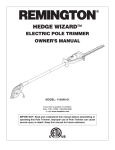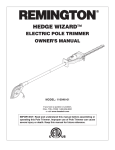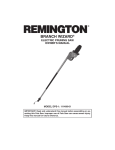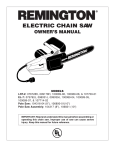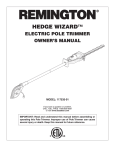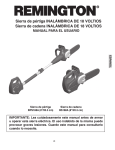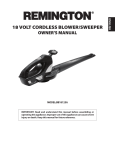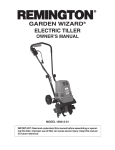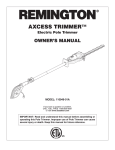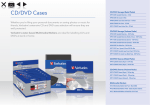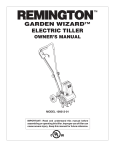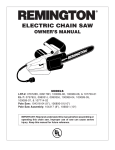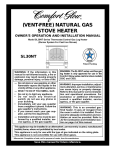Download Homelite UT13130 User's Manual
Transcript
ELECTRIC CHAIN SAW OWNER’S MANUAL ® Model: UT13130 IMPORTANT: Read and understand this manual before assembling or operating this chain saw. Improper use of saw can cause severe injury. Keep this manual for future reference. ELECTRIC CHAIN SAW SAFETY WARNINGS Make certain you read and understand all Safety Warnings on pages 2 and 3. Improper use of this chain saw can cause severe injury or death from fire, electrical shock, body contact with moving chain, or falling wood. BEFORE OPERATING SAW 1. Read and understand this owner’s manual before operating chain saw. 2. Watch what you are doing. Use common sense. Do not operate saw when you are tired. 3. Use chain saw for cutting wood only. Do not use chain saw for purpose not intended. Do not use for cutting plastic, masonry, etc. 4. Only well-instructed adults should operate chain saw. Never allow children to operate chain saw. 5. Use only electrical voltage noted on model plate of chain saw. 6. Use only extension cords marked for outdoor use. See page 8 for extension cord requirements. 7. Do not operate chain saw • while under the influence of alcohol, medication, or drugs • in rain or in damp or wet areas • where highly flammable liquids or gases are present • if saw is damaged, adjusted wrong, or not fully and securely assembled • if trigger does not turn saw on and off. Chain must stop moving when you release trigger. Have faulty switch replaced by authorized service center. • while in a hurry • while in tree or on a ladder unless trained to do so 8. Wear snug-fitting clothes when operating chain saw. Do not wear loose clothing or jewelry. They can get caught in moving saw chain. 9. Wear the following safety gear when operating chain saw. • heavy-duty gloves (wear rubber gloves when working outdoors) • steel-toed safety footwear with nonskid soles • eye protection such as safety glasses, goggles, or face screen • safety hard hat • ear mufflers or ear plugs • hair covering to contain long hair • face or dust mask (if working in dusty areas) 10. Before cutting, always provide the following: • clear work area • secure footing • planned retreat path from falling tree 11. Inspect tree before cutting down. Make sure there are no dead limbs or branches that may fall on you. 12. To reduce the risk of electric shock, this saw has a polarized plug (one blade is wider than the other). This plug will fit in a polarized outlet only one way. If the plug does not fit fully in the outlet of your extension cord, reverse the plug. If it still does not fit, a polarized extension cord will be necessary. Do not change the plug in any way. While operating saw 1. Stay alert. Use common sense while operating chain saw. 2. Keep work area clean. Cluttered areas invite injuries. 3. Be aware of extension cord while operating chain saw. Be careful not to trip over cord. Keep cord away from chain and operator at all times. 4. Keep children, animals, and bystanders away from chain saw and extension cord. Only chain saw user should be in work area. 5. Do not cut down a tree unless you are trained or have expert help. 6. If two or more persons perform bucking and felling operations at the same time, provide plenty of distance between operations. Provide distance of at least twice the height of tree being felled. 7. Secure wood you are cutting by using clamps or chocks. 8. Grip chain saw firmly with both hands. Never operate chain saw with one hand. Never use hand guard as handle. 9. Keep finger off trigger until ready to make cut. 10. Before starting chain saw, make sure chain is not touching anything. 11. To guard against electrical shock, avoid For more information, visit www.desatech.com body contact with grounded objects such as pipes, fences, and metal posts. 12. Keep all parts of body away from chain when saw is running. 13. Do not force chain saw while cutting. Apply light pressure. It will do the job better and safer at the rate for which it was intended. 14. Cut small brush and saplings with extreme care. Slender material may catch in chain and be whipped toward you. This could also pull you off balance. 15. When cutting limb or tree trunk that is under tension, use extreme caution. Be alert for wood springing back. When wood tension is released, limb could spring back and strike operator causing severe injury or death. 16. Carry chain saw from one place to another • with saw stopped and unplugged • by holding front handle (never use hand guard as handle) • with finger off trigger • with guide bar and chain to rear WARNING: This product contains chemicals known to the State of California to cause cancer or birth defects, or other reproductive harm. WARNING: Some dust created by power sanding, sawing, grinding, drilling, and other construction activities contains chemicals known (to the state of California) to cause cancer, birth defects, or other reproductive harm. Some examples of these chemicals are: • lead from lead-based paints • crystalline silica from bricks and cement and other masonry products • arsenic and chromium from chemically-treated lumber Your risk from these exposures varies, depending on how often you do this type of work. To reduce your exposure to these chemicals: work in a well ventilated area, and work with approved safety equipment, such as those dust masks that are specially designed to filter out microscopic particles. 120693 OWNER’S MANUAL MAINTENANCE AND STORAGE OF CHAIN SAW SAFETY WARNINGS KICKBACK WARNING: Kickback may occur when the nose or tip of the guide bar touches an object, or when the wood closes in and pinches the saw chain in the cut. Tip contact in some cases may cause a lightning fast reverse reaction, kicking the guide bar up and back towards the operator. Pinching the saw chain along the top of the guide bar may push the guide bar rapidly back towards the operator. Either of these reactions may cause you to lose control of the saw which could result in serious injury to user. Kickback Safety Devices On This Saw This saw has a low-kickback chain and reduced kickback guide bar. Both items reduce the chance of kickback. Kickback can still occur with this saw. Properly install front hand guard. This item can reduce injuries from kickback. Follow assembly instructions on page 6. Do not remove front hand guard. Do not replace front hand guard with substitute. The following steps will reduce the risk of kickback. • Use both hands to grip saw while saw is running. Use firm grip. Thumbs and fingers must wrap around saw handles. • Keep all safety items in place on saw. Make sure they work properly. • Do not overreach or cut above shoulder height. • Keep solid footing and balance at all times • Stand slightly to left side of saw. This keeps your body from being in direct line with chain. • Do not let guide bar nose touch anything when chain is moving (see Figure 1). 120693 Direction Do Not Let Guide Bar Touch Here 90° Quadrant Figure 1 - Kickback Hazard Example: Do Not Let Nose of Guide Bar Touch Object While Chain is Moving • Never try cutting through two logs at same time. Only cut one log at a time. • Do not bury guide bar nose or try plunge cut (boring into wood using guide bar nose). • Watch for shifting of wood or other forces that may pinch chain. • Use extreme caution when reentering a previous cut. • Use low-kickback chain and guide bar supplied with this chain saw. Only replace these parts with chains and guide bars listed in this manual. • Never use dull or loose chain. Keep chain sharp with proper tension. • Do not hand sharpen chain on automatic chain sharpening (Fast Sharp) models. Saw Maintenance and Kickback Safety Follow maintenance instructions in this manual. Proper cleaning of saw and chain and guide bar maintenance can reduce chances of kickback. Inspect and maintain saw after each use. This will increase the service life of your saw. Note: Even with proper sharpening, risk of kickback can increase with each sharpening. 1. Unplug chain saw from power source • when not in use • before moving from one place to another • before servicing • before changing accessories or attachments, such as saw chain and guard 2. Inspect chain saw before and after each use. Check saw closely if guard or other part has been damaged. Check for any damage that may affect operator safety or operation of saw. Check for alignment or binding of moving parts. Check for broken or damaged parts. Do not use chain saw if damage affects safety or operation. Have damage repaired by authorized service center. 3. Maintain chain saw with care. • Never expose saw to rain. • Keep chain sharp, clean, and lubricated for better and safer performance. • Follow steps outlined in this manual to sharpen chain. • Keep handles dry, clean, and free of oil and grease. • Keep all screws and nuts tight. • Inspect power cord often. If damaged, have repaired by authorized service center. • Never carry chain saw by power cord. • Never yank power cord to unplug it. • Keep power cord from heat, oil, and sharp edges. • Inspect extension cords often and replace if damaged. 4. When servicing, use only identical replacement parts. 5. When not in use, always store chain saw • in a high or locked place, out of children’s reach • in a dry place • in a carrying case or with scabbard over guide bar Keep this manual for reference. It is your guide to safe and proper operation of this chain saw. For more information, visit www.desatech.com ELECTRIC CHAIN SAW Chain saw names and terms Bucking Process of cutting a felled tree or log into lengths. Felling Process of cutting down a tree. Felling Cut Final cut when felling a tree. Make this cut on opposite side of tree from notching cut. Front Handle Located at front of saw body. Front Hand Guard Shield between front handle and guide bar. Protects left hand while using saw. Guide Bar Metal bar that extends from saw body. The guide bar supports and guides chain. Guide Bar Nose Tip or end of guide bar. Kickback Quick backward and upward motion of guide bar. Kickback may occur when tip of guide bar touches an object while chain is moving. The guide bar will kick up and back towards operator. Limbing Process of cutting limb(s) from a felled tree. Low-Kickback Chain Chain that reduces chance of kickback as required by ANS B175.1. Spiked Bumper (Spike) Pointed teeth at Normal Cutting Position Stance used while making bucking and felling cuts. front of saw body beside guide bar. Keep spiked bumper in contact with wood when felling or bucking. It helps maintain position of saw while cutting. Notching Cut Notch cut in tree that directs Sprocket Toothed wheel that drives fall of tree. chain. Oiler Control System for oiling guide bar Switch Device that completes or interrupts and chain. electrical circuit to motor of saw. Power Head Chain saw without chain and Switch Linkage This device connects switch to trigger. It moves switch when you squeeze trigger. guide bar. Also known as saw body. Pushback (Kickback, Pinch) Rapid push- back of chain saw. Pushback may occur if chain along top of guide bar is pinched, caught, or contacts a foreign object. Switch Lockout Device that reduces ac- cidental starting of saw. Rear Handle Handle located at rear of Trigger Device that turns saw on and off. Squeezing trigger turns saw on. saw body. Releasing trigger turns saw off. Reduced Kickback Guide Bar Guide bar that reduces chance of kickback. Trimming (Pruning) Process of cutting limb(s) from a living tree. Replacement Chain Chain that complies Undercut An upward cut from underside of log or limb. This is done while in normal cutting position and cutting with top of guide bar. with ANS B175.1 when used with a specific saw. It may not meet ANS requirements when used with other saws. Saw Chain (Chain) Loop of chain having cutting teeth for cutting wood. The motor drives chain. The guide bar supports chain. For more information, visit www.desatech.com 120693 OWNER’S MANUAL PRODUCT IDENTIFICATION Front Hand Guard UNPACKING 1. Remove all items from carton. 2. Check all items for any shipping damage. If you find any damage or if any parts are missing, promptly inform dealer where you bought chain saw. Guide Bar Nose Saw Chain Rear Handle Guide Bar Sprocket Cover Rear Hand Guard Scabbard Power Cord Oil Level Sight Hole (located on saw body, hidden by front handle) Oil Cap With Squeeze Bulb Front Handle Spike Motor Housing Switch Lockout Trigger Figure 2 - Electric Chain Saw 120693 For more information, visit www.desatech.com ELECTRIC CHAIN SAW ASSEMBLY Note: Some models are pre assembled. Assembly is not needed on these models. See Saw Chain Tension Adjustment, page 7. WARNING: Cutting edges on chain are sharp. Use protective gloves when handling chain. 8. Place chain around drive sprocket, then along top groove of guide bar and around guide bar nose. Note: Make sure cutting edges of chain are facing the right direction. Position chain so cutting edges on top of guide bar face guide bar nose (see Figure 3). Tapping Screw IMPORTANT: Do not clamp chain saw in vise during assembly. The plastic hardware bag should include: • two guide bar bolts • two guide bar nuts • one Phillips-head tapping screw • automatic chain sharpener (Fast Sharp models only) 1. Lay chain out flat. 2. Install front hand guard onto saw body. Do this by pressing two mounting standouts on hand guard into hex-shaped holes in saw body (see Figure 3). 3 Insert tapping screw through hand guard and into saw handle. Tighten screw firmly. 4. Turn adjusting screw counterclockwise (see Figure 4). Continue to turn adjusting screw until adjusting block is to rear of adjusting plate. 5. Install guide bar onto saw body. Place rear of guide bar between adjusting plate and sprocket support. IMPORTANT: Make sure to insert adjusting block into oval adjusting hole on guide bar. 6. Line up holes on sprocket support with center slot on guide bar and holes in saw body. 7. Insert guide bar bolts through front hand guard, saw body, center slot of guide bar, and sprocket support. Attach guide bar nuts to guide bar bolts. IMPORTANT: Tighten guide bar nuts finger tight only. Make sure adjusting block is in oval adjusting hole on guide bar. CAUTION: Do not place chain on saw backwards. If chain is backwards, saw will vibrate badly and will not cut. 9. Adjust saw chain tension. Follow steps under Saw Chain Tension Adjustment, page 7. Front Hand Guard Towards Guide Bar Nose Cutting Edge Cutting Edge Guide Bar Bolts Mounting Stand-Outs Saw Chain Drive Sprocket Guide Bar Adjusting Hole Guide Bar Nuts Figure 3 - Assembling Guide Bar, Chain, and Hand Guard Adjusting Block Adjusting Plate Adjusting Screw Sprocket Support Figure 4 - Part Locations For Assembling Guide Bar For more information, visit www.desatech.com 120693 OWNER’S MANUAL SAW CHAIN TENSION ADJUSTMENT WARNING: Unplug chain saw from power source before adjusting saw chain tension. 4. After chain tension is correct, tighten guide bar nuts firmly. If not, guide bar will move and loosen chain tension. This will increase the risk of kickback. This can also damage saw. Note: A new chain will stretch. Check new chain after first few minutes of operation. Allow chain to cool down. Readjust chain tension. WARNING: Cutting edges on chain are sharp. Use protective gloves when handling chain. FILLING OIL TANK 1. Remove oil cap. 2. Fill oil tank with SAE #30 motor oil. Note: For temperatures below 30°F, use SAE #10 oil. For temperatures above 75°F, use SAE #40 oil. 3. Replace oil cap at once. Tighten oil cap firmly for good seal. This will avoid oil seepage from tank. 4. Wipe off excess oil. Note: It is normal for oil to seep when saw is not in use. Empty oil tank after each use to prevent seepage. WARNING: Maintain proper chain tension always. A loose chain will increase the risk of kickback. A loose chain may jump out of guide bar groove. This may injure operator and damage chain. A loose chain will cause chain, guide bar, and sprocket to wear rapidly. Note: For pre-assembled models, the saw chain tension is properly set at factory. A new chain will stretch. Check new chain after first few minutes of operation. Allow Figure 5 - Turning Adjusting Screw chain to cool down. Follow steps below to readjust saw chain tension. Guide Bar Nuts 1. Before adjusting chain, make sure guide bar nuts are only finger tight (see Figure 3, page 6). Also make sure adjusting block is in oval adjusting hole on guide bar (see Figures 3 and 4, page 6). Guide Bar 2. Turn adjusting screw clockwise until all slack is out of chain (see Figure 5). Note: There should be no gap between Guide Bar side links of chain and bottom of guide bar (see Figure 6). Correct 3. Wearing protective gloves, move chain Tension Gap around guide bar. Chain should move freely. If chain does not move freely, Incorrect loosen chain by turning adjusting screw Tension counterclockwise. Figure 6 - Saw Chain Adjustment 120693 For more information, visit www.desatech.com ELECTRIC CHAIN SAW OPERATING CHAIN SAW Keep cord away from cutting area. Make sure cord does not catch on branches or logs during cutting. Inspect cords often. Replace damaged cords. WARNING: Read and understand this owner’s manual before operating this saw. Make certain you read and understand all Safety Warnings, pages 2 and 3. Improper use of this chain saw can cause severe injury or death from fire, electrical shock, or body contact with moving chain, or falling wood. The extension cord may come undone from the power cord during use. To avoid this, make a knot with the two cords as shown in Figure 7 below. Chain Saw Power Cord Extension Cord Extension Cords Use proper extension cords with this saw. Use only extension cords marked for outdoor use. The cord must be marked with suffix W or W-A following the cord type designation. Example: SJTW-A or SJTW. Use proper sized cord with this saw. Cord must be heavy enough to carry current needed. An undersized cord will cause voltage drop at saw. Saw will lose power and overheat. Follow cord size requirements listed below. Cord Length AWG Cord Size 25 feet 16 AWG 50 feet 16 AWG 100 feet 16 AWG 150 feet 14 AWG Figure 7 -Tying Extension Cord and Power Cord in Knot OILING CHAIN Always check oil level before using saw. To oil chain, press squeeze bulb on oil cap. Do not attempt to operate the oiler while cutting with the saw. Oil will feed onto guide bar and chain. Press squeeze bulb on oil cap at least once before each cut. Check oil level often by looking at oil sight level hole. Oil sight level hole is on left side of saw, between front handle and front hand guard. Model: UT13130 CUTTING WITH THE CHAIN SAW 1. Connect saw to extension cord. Connect extension cord to power supply. 2. Make sure section of log to be cut is not laying on ground. This will keep chain from touching ground as it cuts through log. Touching ground with moving chain will dull chain. 3. Use both hands to grip saw. Always use left hand to grip front handle and right hand to grip rear handle. Use firm grip. Thumbs and fingers must wrap around saw handles (see Figure 9). 4. Make sure your footing is firm. Keep feet apart. Divide your weight evenly on both feet. 5. When ready to make a cut, press in switch lockout with right thumb and squeeze trigger (see Figure 9). This will turn saw on. Releasing trigger will turn saw off. Make sure saw is running at full speed before starting a cut. 6. When starting a cut, place moving chain against wood. Hold saw firmly in place to avoid possible bouncing or skating (sideways movement) of saw. 7. Guide saw using light pressure. Do not force saw. The motor will overload and can burn out. It will do the job better and safer at the rate for which it was intended. 8. Remove saw from a cut with saw running at full speed. Stop saw by releasing trigger. Make sure chain has stopped before setting saw down. 9. Practice until you can maintain a steady, even cutting rate. Switch Lockout Figure 8 - Pressing Squeeze Bulb on Oil Cap to Oil Chain Trigger Figure 9 - Switch Lockout and Trigger Location For more information, visit www.desatech.com 120693 OWNER’S MANUAL operating chain saw Direction of Fall Retreat Path Direction of Fall Continued FELLING A TREE 2 Inches (Cutting Down a Tree) 45° • • • • WARNING: Avoid kickback. Kickback can result in severe injury or death. See Kickback, page 3 to avoid risk of kickback. Do not fell a tree without ample skill or expert help. Keep children, animals, and bystanders away from area when felling a tree. If two or more persons perform bucking and felling operations WARNING:When felling a tree, be aware of your surroundings. Do not endanger any person, strike utility lines, or cause property damage. If tree strikes utility lines, contact utility company at once. Felling is the process of cutting down a tree. Make sure your footing is firm. Keep feet apart. Divide your weight evenly on both feet. Follow directions below to fell a tree. Before Felling a Tree 1. Before felling, inspect tree. Make sure there are no dead limbs or branches that may fall on you. Study natural lean of tree, location of larger branches, and wind direction. This will help you judge which way tree will fall. 2. Clear work area around tree. 3. Plan and clear a retreat path before felling. Make retreat path opposite to planned direction of fall of tree and at 45° angle (see Figure 10). 4. Remove dirt, stones, loose bark, nails, staples, and wire from tree where you will make felling cuts. 5. Stay on uphill side when felling tree. Tree could roll or slide downhill after falling. Hinge 3rd Cut Felling Cut 2" Retreat Path 2nd Cut Upper Notch Cut 1st Cut Lower Notch Cut Tree Figure 10 - Retreat Path From Tree Felling Procedure A) Felling Notch A properly placed felling notch will determine direction tree will fall. Place felling notch on side of tree in direction you want tree to fall (see Figure 11). Follow directions below to create a felling notch. 1. Make lower notch cut as close to ground as possible. Hold saw so guide bar is horizontal. Cut 1/3 the diameter of tree trunk (see Figure 11). Note: Always make this horizontal lower notch cut first. If you make this cut second, tree can pinch chain or guide bar. 2. Start upper notch cut the same distance above first cut as first cut is deep. Example: If lower notch cut is eight inches deep, start upper notch cut eight inches above it. Cut downward at 45° angle. The upper notch cut should meet end of lower notch cut (see Figure 11). 3. Remove tree trunk wedge created by notching cuts. Figure 11 - Felling A Tree 3. As felling cut nears hinge, tree should begin to fall. Note: If needed, drive wedges into felling cut to control direction of fall. If tree settles back and pinches chain, drive wedges into felling cut to remove saw. Only use wedges made of wood, plastic, or aluminum. Never use wedge made of steel. This could cause kickback and damage to chain. 4. When tree begins to fall, quickly • remove saw from felling cut • release trigger to turn saw off • put saw down • exit area using retreat path WARNING: Be alert for falling overhead limbs. Watch your footing while exiting area. B) Felling Cut 1. Make felling cut two inches higher than lower notch cut and on opposite side of tree (see Figure 11). Keep felling cut parallel to lower notch cut. 2. Cut towards notch. WARNING: Do not cut all the way through tree. Leave about two inches of tree diameter uncut directly behind felling notch (see Figure 11).This uncut portion acts as a hinge. The hinge helps keep tree from twisting and falling in wrong direction. Continued 120693 For more information, visit www.desatech.com ELECTRIC CHAIN SAW OPERATING CHAIN SAW Continued LIMBING A TREE WARNING: Avoid kickback. Kickback can result in severe injury or death. See Kickback, page 3 to avoid risk of kickback. WARNING: When cutting limb that is under tension, use extreme caution. Be alert for wood springing back. When wood tension is released, limb could spring back and strike operator causing severe injury or death. Limbing is removing branches from a fallen tree. Make sure your footing is firm. Keep feet apart. Divide your weight evenly on both feet. Do not remove larger limbs under tree that support log off ground. Remove each limb with one cut (see Figure 12). Clear cut limbs from work area often. This will help maintain a safe work area. Make sure you start your cut where limb will not pinch saw during cutting. To avoid pinching, start cut on freely hanging limbs from above limb. Start cut on limbs under tension from under limb. If pinch occurs, turn saw off, lift limb, and remove saw. BUCKING A LOG WARNING: Avoid kickback. Kickback can result in severe injury or death. See Kickback, page 3 to avoid risk of kickback. WARNING: • If on slope, make sure log will not roll down hill. Secure log by using wooden stakes. Drive wooden stakes into ground on downhill side of log. Stand on uphill side of log while cutting. Log may roll after cutting. • Never try cutting through two logs at same time. This could increase the risk of kickback. • While cutting log, never hold log with your hand, leg, or foot. • While cutting log, never allow another person to hold log. • Turn off and unplug saw before moving from one place to another. Bucking a log is cutting a log into sections. Make sure your footing is firm. Keep feet apart. Divide your weight evenly on both feet. When possible, raise log or section off ground. Do this by using limbs, logs, chocks, etc. When cutting through log, maintain control by reducing cutting pressure near end of cut. Do not relax your grip on chain saw handles. Do not let moving chain touch ground. Ground will dull moving chain. After cutting through log, release trigger to turn saw off before moving saw. Entire Length Of Log On Ground Cut log from top (see Figure 13). Figure 13 - Bucking Log With Entire Length On Ground Log Supported On One End 1. Make first cut on underside of log (see Figure 14). Use top of guide bar to make this cut. Cut 1/3 through diameter of log. This cut will keep section from splintering when cut. 2. Make second cut directly above first cut. Cut down to meet first cut. This cut will keep log from pinching guide bar and chain. 2nd Cut Follow directions below to buck a log. 1st Cut Figure 14 - Bucking Log When Log Is Supported On One End Figure 12 - Limbing A Tree For more information, visit www.desatech.com 10 120693 OWNER’S MANUAL operating chain saw Continued Log Supported On Both Ends 1. Make first cut from above log (see Figure 15). Cut 1/3 through diameter of log. This cut will keep section from splintering when cut. 2. Make second cut on underside of log, directly under first cut. Use top of guide bar to make this cut. Cut up to meet first cut. This will keep log from pinching guide bar and chain. 1st Cut TRIMMING A TREE (Pruning) WARNING: Avoid kickback. Kickback can result in severe injury or death. See Kickback, page 3 to avoid risk of kickback. WARNING: Do not operate chain saw while • in a tree • on a ladder or any other unstable surface • in any awkward position You may lose control of saw causing severe injury. WARNING: Do not cut limbs higher than your shoulders. CAUTION: Seek professional help if facing conditions beyond your ability. 2nd Cut Figure 15 - Bucking Log When Log Is Supported On Both Ends 120693 4th Cut Final Stub Cut 2nd Cut Pruning Cut (to avoid pinching) 6" 2" to 4" 1st Cut Pruning Undercut (to avoid splintering) 3rd Cut - Stub Undercut (to avoid splintering) Figure 16 - Cutting A Limb Trimming a tree is the process of cutting limbs from a living tree. Make sure your footing is firm. Keep feet apart. Divide your weight evenly on both feet. Follow directions below to trim a tree. 1. Make first cut six inches from tree trunk on underside of limb. Use top of guide bar to make this cut. Cut 1/3 through diameter of limb (see Figure 16). 2. Move two to four inches farther out on limb. Make second cut from above limb. Continue cut until you cut limb off. 3. Make third cut as close to tree trunk as possible on underside of limb stub. Use top of guide bar to make this cut. Cut 1/3 through diameter of stub. 4. Make fourth cut directly above third cut. Cut down to meet third cut. This will remove limb stub. 11 For more information, visit www.desatech.com ELECTRIC CHAIN SAW CLEANING AND MAINTENANCE NOTICE: Below are instructions for servicing your chain saw. Any servicing not mentioned below should be done by an authorized service center. CLEANING SAW BODY WARNING: Unplug chain saw from power source before servicing. Severe injury or death could occur from electrical shock or body contact with moving chain. CARE OF GUIDE BAR Normal Guide Bar Maintenance Uneven bar wear causes most guide bar problems. Incorrect sharpening of chain cutter and depth gauge settings often cause this. When bar wears unevenly, it widens guide bar groove (see Figure 17). This causes chain clatter and rivet popping. Saw will not cut straight. Replace guide bar if this occurs. 1. Remove guide bar from chain saw. 2. Remove sawdust from guide bar groove periodically. Use putty knife or wire. 3. Clean oil slots after each day of use. 4. Remove burrs from sides of guide bar. Use flat file to make side edges square. Inspect guide bar before sharpening chain. A worn or damaged guide bar is unsafe. A worn or damaged guide bar will damage chain. It will also make cutting harder. Guide Bar Groove Replace guide bar when • bar is bent or cracked • inside groove of bar is badly worn Note: When replacing guide bar, see Replacement Parts and Accessories, page 19, for proper bar. Burr WARNING: Cutting edges on chain are sharp. Use protective gloves when handling chain. Guide Bar WARNING: When cleaning saw body, • do not submerge saw in any liquids • do not use products that contain ammonia, chlorine, or abrasives • do not use chlorinated cleaning solvents, carbon tetrachloride, kerosene, or gasoline Keep saw body clean. Use a soft cloth dampened with a mild soap and water mixture. Wipe saw body to clean. Flat File Guide Bar Guide Bar With Uneven Wear Normal Guide Bar Figure 17 - Guide Bar Cross Section Showing Uneven Bar Wear Cleaning Groove With Putty Knife Oil Slot Figure 18 - Guide Bar Maintenance For more information, visit www.desatech.com 12 120693 OWNER’S MANUAL cleaning and maintenance Continued SHARPENING SAW CHAIN WARNING: Unplug chain saw from power source before servicing. Severe injury or death could occur from electrical shock or body contact with moving chain. WARNING: Cutting edges on chain are sharp. Use protective gloves when handling chain. Use file guide for 30° filing. 1. Adjust chain for proper tension (see Saw Chain Tension Adjustment, page 7). 2. Clamp guide bar in vise to hold saw steady. Note: Do not clamp chain. 3. Press 5/32" round file (attached to file guide) into groove between top plate and depth gauge on chain. File guide should rest on both top plate and depth gauge (see Figures 19 and 20). Note: File at midpoint of guide bar. Filing Direction 30° Guide Mark File Guide 5/32" Round File HOLDER Items Needed to Sharpen Chain Purchase these items from your local dealer, hardware store, or chain saw supplies outlet. • 5/32" round file • Depth gauge tool • File guide • Vise • Medium sized flat file 4. Hold file guide level. Make sure 30° mark on file guide is parallel to center of guide bar (see Figure 19). This will insure that you file cutters at 30° angle. 5. File from inside towards outside of cutter until sharp. Only file in this one direction (see Figure 19). Note: Two or three strokes with file should sharpen cutter. 6. After each cutter is sharpened, move chain forward to sharpen next cutter. File all cutters on one side of chain. 7. Move to other side of chain and repeat process. FILE Keep chain sharp. Your saw will cut faster and more safely. A dull chain will cause undue sprocket, guide bar, chain, and motor wear. If you must force chain into wood and cutting creates only sawdust with few large chips, chain is dull. Sharpening Cutters Note: This illustration shows file guide placement and filing direction for sharpening cutters on left side of chain. Figure 19 - File and File Guide Placement On Chain Depth Gauge (left side of chain) Groove Depth Gauge (right side of chain) Left Side of Chain Groove Top Plate (right side of chain) Top Plate (left side of chain) Right Side of Chain Figure 20 - Chain Part Locations Continued 120693 13 For more information, visit www.desatech.com ELECTRIC CHAIN SAW CLEANING AND MAINTENANCE Replacing Saw Chain Continued Filing Cutter Depth Gauges The cutter depth gauge clearance is reduced as cutters are sharpened. After every second or third sharpening, reset cutter depth gauges. 1. Place depth gauge tool (.025") firmly across top of two cutters. Make sure depth gauge enters slot in depth gauge tool (see Figure 21). 2. Use medium flat file. File depth gauge level with depth gauge tool. 3. Remove depth gauge tool. With flat file, round off front corner of cutter depth gauge (see Figure 22). Replace chain when cutters are too worn to sharpen or when chain breaks. Only use replacement chain noted in this manual. Always include new drive sprocket when replacing chain. This will maintain proper driving of chain. Note: For proper chain and drive sprocket, see Replacement Parts and Accessories, page 19. After several hand filings, have authorized service center or sharpening service machine sharpen chain. This will insure even filing. Flat File STORAGE If storing saw for more than 30 days, follow steps below. 1. Drain oil tank. 2. Remove and clean guide bar and chain. Clean guide bar and chain by soaking in petroleum based solvent or mild soap and water mixture. 3. Dry guide bar and chain. 4. Place chain in container filled with oil. This will prevent rust. 5. Wipe a thin coating of oil over surface of guide bar. 6. Wipe off outside of saw body. Do this with soft cloth dampened with a mild soap and water mixture. 7. Store chain saw • in a high or locked place, out of children’s reach • in a dry place • in a carrying case or with scabbard over guide bar Depth Gauge Depth Gauge Tool Depth Gauge Slot Figure 21 - Depth Gauge Tool On Chain Front Corner .025" Figure 22 - Round Off Front Corner Of Depth Gauge For more information, visit www.desatech.com 14 120693 OWNER’S MANUAL TROUBLESHOOTING Note: For additional help, visit our technical service web site at www. desatech.com. WARNING: Unplug chain saw from power source before servicing. Severe injury or death could occur from electrical shock or body contact with moving chain. OBSERVED FAULT POSSIBLE CAUSE REMEDY Saw runs, but does not cut Chain assembled backwards on guide bar See Assembly, page 6 Saw does not cut unless heavily forced. Cutting produces only sawdust with few large chips Chain is dull See Sharpening Saw Chain, page 13 Saw runs slow. Saw stalls easily Low power supply voltage Extension cord wire size too small. See Extension Cords, page 8 Motor of saw does not run when you squeeze trigger 1. Switch lockout not pressed in to release trigger 2. Extension cord connections loose 3. Open line fuse or circuit breaker 4. Bad motor brushes 5. Open wiring circuit on saw 1. Press in switch lockout before squeezing trigger 2. Check cord connections 3. Check line fuse or circuit breaker 4. See authorized service center 5. See authorized service center Motor of saw runs, but chain does not move Gear train failure See authorized service center Chain does not get oil 1. Clogged oil slot in guide bar 2. Oil is too thick 1. Remove guide bar and clean oil slot 2. Use correct weight of oil. See Filling Oil Tank, page 7 Chain comes off guide bar 1. Chain is loose 2. Guide bar and chain not assembled right 1. Tighten chain. See Saw Chain Tension Adjustment, page 7 2. See Assembly, page 6 Saw smokes Saw damaged. Do not use saw See authorized service center Saw leaks oil Oil cap is not secure Tighten oil cap. Note: Empty oil tank when not in use 120693 15 For more information, visit www.desatech.com ELECTRIC CHAIN SAW ILLUSTRATED PARTS BREAKDOWN UT13130 19 13 5 6 18 21 1 2 26 16 21 9 14 10 7 3 4 12 23 15 24 11 17 22 22 20 8 25 22 For more information, visit www.desatech.com 16 E-Ring Installation 120693 OWNER’S MANUAL PARTS LIST UT13130 120693 This list contains replaceable parts used in your chainsaw. When ordering parts, be sure to provide the correct model and serial numbers (from the model plate), then the part number and description of the desired part. KEY NO. PART NO. DESCRIPTION 1 2 3 4 5 6 7 8 9 10 11 12 13 14 15 16 17 18 19 20 21 22 23 24 25 26 14SB 14SC 107481-01 075676 107319-01 107512-01 099829-01 077399-14 076105 107482-01 059606 107713-01 106809-02 079089-07 NPC-4C 077115 075887 079086-02 097403-01 108120-01 076906 107708-01 077143 077525S 106810-01 079963-04 Guide Bar, 14" 1 Saw Chain 1 Armature Assembly 1 Sprocket Roller Bearing 1 Hex-Head Bolt2 Cap & Bulb Assembly 1 Cord 1 Side Cover, Black 1 Thrust Disk 1 Field & Brush Assembly 1 Drive Gear 1 Internal Gear 1 Front Hand Guard 1 Motor Housing, Black 1 Hex Nut2 Adjusting Plate Assembly 1 Bearing Plate 1 Oil Reservoir 1 Pan-Head Screw 1 E-Ring 1 Flat-Head Tap Screw 2 Pan-Head Tap Screw 10 Sprocket Support 1 Lock-Off Switch 1 Sprocket Cover, Black 1 Scabbard 1 17 QTY. For more information, visit www.desatech.com ELECTRIC CHAIN SAW Parts CentralS Ray’s Portable Heater Service 3191 Myers Road Camino, CA 95709-9550 530-644-7716 Tool & Equipment 5 Manila Drive Hamden, CT 06514-0322 203-248-7553 1-800-397-7553 Grainger Parts Operations 1657 Shermer Road Northbrook, IL 60062-5362 708-498-5900 1-800-323-0620 www.grainger.com Portable Heater Parts 342 North County Road 400 East Valparaiso, IN 46383-9704 219-462-7441 1-800-362-6951 www.portableheaterparts.com [email protected] [email protected] FBD 1349 Adams Street Bowling Green, KY 42103-3414 270-846-1199 1-800-654-8534 [email protected] Lyons & Lyons Sales Co. Inc. Glen Arm Road Glen Arm, MD 21057-9454 301-665-6500 1-800-333-5966 [email protected] Master Part Distributors 1251 Mound Avenue NW Grand Rapids, MI 49504-2672 616-791-0505 1-800-446-1446 www.masterparts.net Hance Distributors, Inc. 12795 16th Avenue North Plymouth, MN 55441-4556 763-559-2299 www.hanceco.com Automotive Equipment Service 3117 Holmes Kansas City, MO 64109-1716 816-531-9144 1-800-843-3546 www.aes-lawnparts.com Bowden Electric Motor Service 1681 S. Wesleyan Blvd. Rocky Mount, NC 27803 252-446-4203 East Coast Energy 10 East Route 36 West Long Branch, NJ 07764-1501 1-800-755-8809 Forrest Lytle and Sons, Inc. 740 West Galbraith Road Cincinnati, OH 45231-6002 513-521-1464 Bortz Chain Saw Shop Road #2, Box 64A Oley, PA 19547-9412 610-987-6452 La Porte’s 2444 N 5th Street Hartsville, SC 29550-7704 843-332-0191 MTA Distributors 555 Hickory Hills Blvd. Nashville, TN 37189-9244 615-299-8777 1-800-264-0225 Webbs Appliance Center 1519 Church Street Nashville, TN 37203-3004 615-329-4079 1-800-899-4079 Industrial Hardware 4109 Bainbridge Blvd. Chesapeake, VA 23324-1403 757-543-2232 1-800-788-0008 [email protected] Mills Lawn and Garden 4750-B Baxter Road Virginia Beach, VA 23462 757-490-7001 www.mills-parts.com Tuco Industrial Products 5223 180th Street SW Suite 4A-1 Lynnwood, WA 98037-4506 425-743-9533 1-800-735-1268 www.tucoheat.com 21st Century 2950 Fretz Valley Road Perkasie, PA 18944-4034 215-795-0400 1-800-325-4828 For more information, visit www.desatech.com 18 120693 OWNER’S MANUAL TECHNICAL SERVICE You may have further questions about assembling, operating, or maintaining this product. If so, you can visit our Technical Service web site at www.desatech.com or contact our Technical Service Department at 1-800-858-8501 (English Only). You may also write to: DESA Power Tools ATTN: Technical Service Specialty Products P.O. Box 90004 Bowling Green, KY 42102-9004 When contacting DESA Power Tools, have ready • Your Name • Your Address • Your Phone Number • Model Number of Product • Date of Purchase (Include copy of receipt for written requests). Replacement Parts And accessories repair SERVICE Note: Only use original replacement parts. This will protect your warranty coverage for parts replaced under warranty. WARNING: Use only replacement parts and accessories described in this manual. Use of other parts or accessories could damage saw or injure operator. For original replacement parts and accessories, contact your nearest Authorized Dealer or Authorized Service Center for this product. If they can not supply the part or accessory, contact your nearest Parts Central listed on page 18. Each Authorized Dealer, Authorized Service Center, and Parts Central is independently owned and operated. See pages 16 and 17 for an Illustrated Parts List. If you need additional referral information, contact our Technical Service Department (see Technical Service). Each Authorized Service Center is independently owned and operated. Warranty Service If product requires warranty service, return it to nearest Authorized Service Center. You must show proof of purchase. If faulty materials or workmanship caused damage, we will repair or replace product without charge. Note: Normal wear, misuse, abuse, neglect, or accidental damage is not covered under warranty. Non-Warranty Service If product requires service, return it to nearest Authorized Service Center. Repairs will be billed to you at regular repair list prices. For additional Service Center or warranty information, call 1-800-858-8501 or visit our Technical Service web site at www. desatech.com. In Canada call 1-800-561-3372 for parts information. 120693 UT13130 Part Number 14SB 14SC 107713-01 Description Guide bar, 14" Chain, 14" Drive sprocket General Part Number 079963-04 106809-02 077155 Description Plastic scabbard, 14" Hand Guard Adjusting Plate Assy. 19 For more information, visit www.desatech.com WARRANTY INFORMATION Homelite brand ELECTRIC CHAIN SAW LIMITED WARRANTIES New Products Standard Warranty DESA Power Tools warrants this new product and any parts thereof to be free from defects in material and workmanship for a period of one (1) year from the date of first purchase from an authorized dealer provided the product has been maintained and operated in accordance with DESA Power Tools’ warnings and instructions. Factory Reconditioned Products Limited Warranty DESA Power Tools warrants factory reconditioned products and any parts thereof to be free from defects in material and workmanship for 90 days from the date of first purchase from an authorized dealer provided the product has been installed, maintained and operated in accordance with DESA Power Tools’ warnings and instructions. Terms Common to All Warranties The following terms apply to all of the above warranties: • Always specify model number when contacting the manufacturer. To make a claim under this warranty the bill of sale or other proof of purchase must be presented. • This warranty is extended only to the original retail purchaser when purchased from an authorized dealer. • This warranty covers the cost of part(s) required to restore this product to proper operating condition and an allowance for labor when provided by a DESA Power Tools Authorized Service Center. Warranty parts must be obtained through authorized dealers of this product and/or DESA Power Tools who will provide original factory replacement parts. Failure to use original factory replacement parts voids this warranty. • Travel, handling, transportation, diagnostic, material, labor and incidental costs associated with warranty repairs, unless expressly covered by this warranty, are not reimbursable under this warranty and are the responsibility of the owner. • Excluded from this warranty are products or parts that fail or become damaged due to misuse, accidents, lack of proper maintenance, tampering, or alterations. • Excluded from this warranty are products purchased for commercial, industrial or rental usage. • This is DESA Power Tools’ exclusive warranty, and to the full extent allowed by law; this express warranty excludes any and all other warranties, express or implied, written or verbal and limits the duration of any and all implied warranties, including warranties of merchantability and fitness for a particular purpose to one (1) year on new products and 90 days on factory reconditioned products from the date of first purchase. DESA Power Tools makes no other warranties regarding this product. • DESA Power Tools’ liability is limited to the purchase price of the product, and DESA Power Tools shall not be liable for any other damages whatsoever under any circumstances including indirect, incidental, or consequential damages. • Some states do not allow limitations on how long an implied warranty lasts or the exclusion or limitation of incidental or consequential damages, so the above limitation or exclusion may not apply to you. • This warranty gives you specific legal rights, and you may also have other rights which vary from state to state. For information about this warranty contact: P.O. Box 90004 Bowling Green, KY 42102-9004 www.desatech.com 82 Akron Road Toronto, Ontario M8W 1T2 1-800-561-3372 Fax: 1-800-561-8003 Model _ ______________ Date Purchased _ ______________ 120693-01 Rev. A 11/06




















